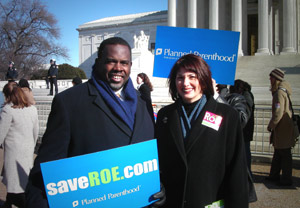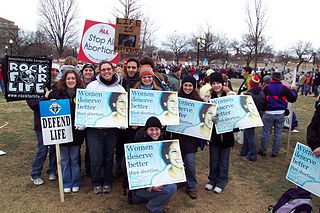Roe v. Wade, 410 U.S. 113 (1973), was a landmark decision of the U.S. Supreme Court in which the Court ruled that the Constitution of the United States generally protected a right to have an abortion. The decision struck down many abortion laws, and caused an ongoing abortion debate in the United States about whether, or to what extent, abortion should be legal, who should decide the legality of abortion, and what the role of moral and religious views in the political sphere should be. The decision also shaped debate concerning which methods the Supreme Court should use in constitutional adjudication.
Planned Parenthood v. Casey, 505 U.S. 833 (1992), was a landmark decision of the Supreme Court of the United States in which the Court upheld the right to have an abortion as established by the "essential holding" of Roe v. Wade (1973) and issued as its "key judgment" the restoration of the undue burden standard when evaluating state-imposed restrictions on that right. Both the essential holding of Roe and the key judgment of Casey were overturned by the Supreme Court in 2022, with its landmark decision in Dobbs v. Jackson Women's Health Organization.

The United States abortion-rights movement is a sociopolitical movement in the United States supporting the view that a woman should have the legal right to an elective abortion, meaning the right to terminate her pregnancy, and is part of a broader global abortion-rights movement. The movement consists of a variety of organizations, with no single centralized decision-making body.

The United States is a global outlier among developed countries on the issue of abortion, with the subject being divisible in American politics and culture wars to an extent not found elsewhere. There are widely different abortion laws depending on state.

R v Morgentaler, [1988] 1 SCR 30 was a decision of the Supreme Court of Canada which held that the abortion provision in the Criminal Code was unconstitutional because it violated women's rights under section 7 of the Canadian Charter of Rights and Freedoms ("Charter") to security of the person. Since this ruling, there have been no criminal laws regulating abortion in Canada.
Gerald N. Rosenberg is an American political science and law professor at the University of Chicago, and the author of the 1991 book The Hollow Hope, now in its 3rd edition (2023).

BVerfGE 39,1 — Abortion I was a decision of the Federal Constitutional Court of Germany, addressing the issue of abortion in 1975, two years after the United States Supreme Court decision Roe v. Wade. The Court held that respect for human dignity requires the criminalization of abortion if it is not justified by imperative reasons called indications ("Indikationen"). There are several indications, most notably the medical indication, meaning that the life of the mother would be at risk if she had to carry the child to term, and the criminal indication, meaning that the child is the result of the mother being raped.
Rust v. Sullivan, 500 U.S. 173 (1991), was a case in the United States Supreme Court that upheld Department of Health and Human Services regulations prohibiting employees in federally funded family-planning facilities from counseling a patient on abortion. The department had removed all family planning programs that involving abortions. Physicians and clinics challenged this decision within the Supreme Court, arguing that the First Amendment was violated due to the implementation of this new policy. The Supreme Court, by a 5–4 verdict, allowed the regulation to go into effect, holding that the regulation was a reasonable interpretation of the Public Health Service Act, and that the First Amendment is not violated when the government merely chooses to "fund one activity to the exclusion of another."

The United States anti-abortion movement contains elements opposing induced abortion on both moral and religious grounds and supports its legal prohibition or restriction. Advocates generally argue that human life begins at conception and that the human zygote, embryo or fetus is a person and therefore has a right to life. The anti-abortion movement includes a variety of organizations, with no single centralized decision-making body. There are diverse arguments and rationales for the anti-abortion stance. Some anti-abortion activists allow for some permissible abortions, including therapeutic abortions, in exceptional circumstances such as incest, rape, severe fetal defects, or when the woman's health is at risk.

McCorvey v. Hill, 385 F.3d 846, was a case in which the original litigant in Roe v. Wade, Norma McCorvey, also known as 'Jane Roe', requested the overturning of Roe. The U.S. Court of Appeals for the Fifth Circuit ruled that McCorvey could not do this; the United States Supreme Court denied certiorari on February 22, 2005, rendering the opinion of the Fifth Circuit final. The opinion for the Fifth Circuit was written by Judge Edith Jones, who also filed a concurrence to her opinion for the court.

On October 3, 2005, Harriet Miers was nominated for Associate Justice of the U.S. Supreme Court by President George W. Bush to replace retired Associate Justice Sandra Day O'Connor. Miers was, at the time, White House Counsel, and had previously served in several roles both during Bush's tenure as Governor of Texas and President.

Americans United for Life (AUL) is an American anti-abortion law firm and advocacy group based in Washington, D.C. Founded in 1971, the group opposes abortion, euthanasia, assisted suicide, embryonic stem cell research, and certain contraceptive methods. The organization has led campaigns and been involved in judicial actions to prevent the passage and implementation of legislation that permits abortion, or may increase prevalence of abortion, including successfully defending the Hyde Amendment in the U.S. Supreme Court.
The Republican Majority for Choice (RMC) was a Republican organization in the United States dedicated to preserving legal access to abortion. The group also supported federal funding for all kinds of stem cell research, including embryonic stem cell research.
Robert Leonard Schenck is an American Evangelical clergyman who has ministered to elected and appointed officials in Washington, D.C. and serves as president of a non-profit organization named for Dietrich Bonhoeffer. Schenck founded the organization Faith and Action in 1995 and led it until 2018. He is the subject of the Emmy Award-winning 2016 Abigail Disney documentary, The Armor of Light. Schenck stated that he was part of a group that paid Norma McCorvey to lie that she had changed her mind and become against abortion. Once a prominent anti-abortion activist, Schenck has since repudiated this work and expressed support for the legality of abortion. In 2022, Schenck testified before the House Judiciary Committee concerning his allegation that a member of the Supreme Court leaked information about a pending case before the Court.
June Medical Services, LLC v. Russo, 591 U.S. ___ (2020), was a United States Supreme Court case in which the Court ruled that a Louisiana state law placing hospital-admission requirements on abortion clinics doctors was unconstitutional. The law mirrored a Texas state law that the Court found unconstitutional in 2016 in Whole Woman's Health v. Hellerstedt (WWH).
Abortion in Massachusetts is legal at all stages of pregnancy, although terminations after the 24th week can only be performed if a physician determines it to be medically necessary. Modern Massachusetts is considered one of the most pro-choice states in the country: a PEW research poll finding that 74% of residents supported the right to an abortion in all or most cases, a higher percentage than any other state. Marches supporting abortion rights took place as part of the #StoptheBans movement in May 2019.
Abortion in the U.S. state of Virginia is legal up to the end of the second trimester of a pregnancy. Before the year 1900, abortion remained largely illegal in Virginia, reflecting a widespread trend in many U.S. states during the 19th and early 20th centuries. Abortion was viewed as a criminal act and subject to state laws that prohibited it. However, by 1950, Virginia introduced a legal therapeutic exception, allowing for abortion under specific circumstances, primarily when a woman's physical or mental health was at risk. Notably, the University of Virginia Hospital established a review board in 1950 responsible for evaluating and approving abortion requests, particularly those grounded in psychiatric reasons. This thorough approval process resulted in a significant decrease in the number of abortions performed at the hospital.
Abortion in Puerto Rico is legal throughout pregnancy. On June 22, 2022, the Senate passed a bill limiting abortion to 22 weeks, with exceptions for danger to the mother's life, fetal defects, and if the fetus would not be viable. The bill will need to be considered by the House.
Dobbs v. Jackson Women's Health Organization, No. 19-1392, 597 U.S. 215 (2022), is a landmark decision of the U.S. Supreme Court in which the court held that the Constitution of the United States does not confer a right to abortion. The court's decision overruled both Roe v. Wade (1973) and Planned Parenthood v. Casey (1992), returning to individual states the power to regulate any aspect of abortion not protected by federal law.







